Chinese smartphone brand OnePlus at an event in London last month announced OnePlus 6 – one of the most awaited flagships of 2018. And later next day, OnePlus launched the OnePlus 6 in India and China. As one would expect, the OnePlus 6 is a total beast as it comes with Qualcomm’s latest and greatest Snapdragon 845 SoC under the hood which is paired with 6 or 8 GB RAM. And to handle graphically intensive tasks, the Snapdragon 845 is backed by Adreno 630 GPU.
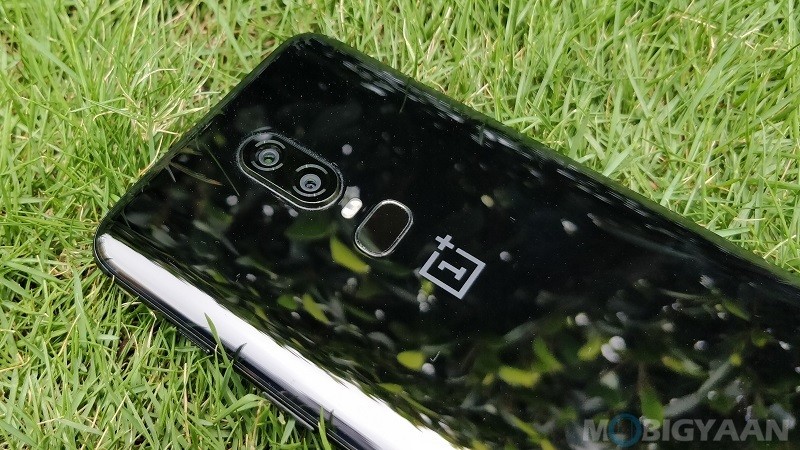
That said, on the software front, the OnePlus 6 comes with OnePlus’ custom Android skin – OxygenOS 5.1 – which is based on Android 8.1 Oreo. If you have used any OnePlus smartphone from recent years, you must be aware that OxygenOS is very much close to stock Android. However, despite of being close to stock Android, the OxygenOS on OnePlus 6 does come with some useful customizations that makes using the OnePlus 6 a great experience.
If you happen to be a OnePlus 6 owner, we have compiled a list of OnePlus 6 tips, tricks and hidden features that should help you make the most out of this 2018 OnePlus flagship.
1) Hide the Notch
The OnePlus 6 comes with a notch. While some of you may like it, we are pretty sure that there are many users who hate the notch up top on the OnePlus 6. If you are someone who doesn’t like looking at that notch, you can get rid of it. Of course not physically, but through software trickery.
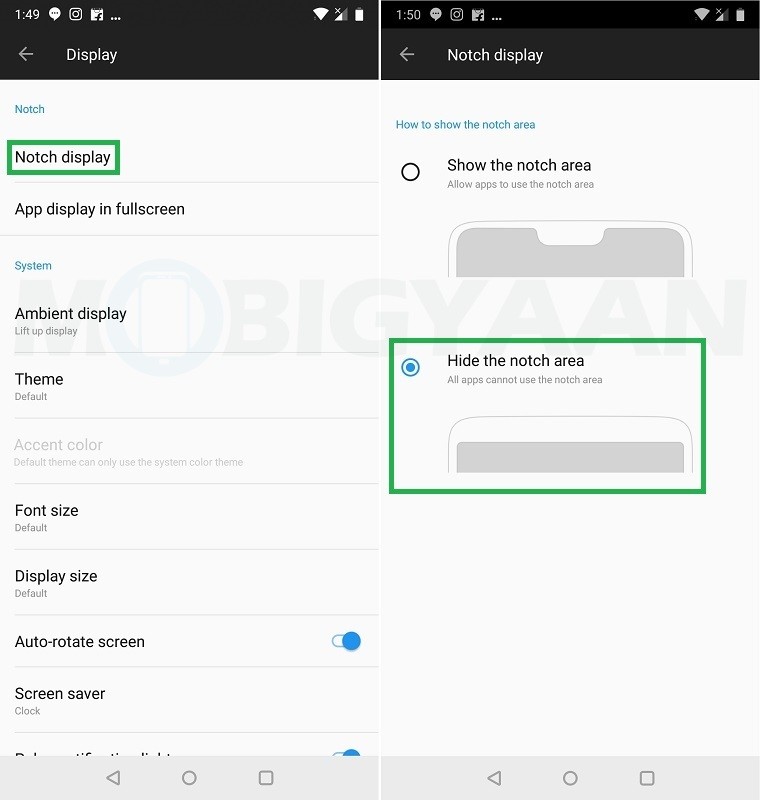
You can get rid of this notch on the OnePlus 6 by hiding it. To do that, head over to the Settings > Display > Notch display menu and then select the ‘Hide the notch area’ option. This will instantly bring black bars around the notch area making the notch invisible to you.
2) Enable On-Screen Navigation Gestures
The OnePlus 6 not only comes with the iPhone X-like notch, but it also comes with iPhone X-like on-screen navigation gestures. As the name suggests, you can navigate through the UI by using different gestures on the screen instead of using the on-screen navigation buttons.
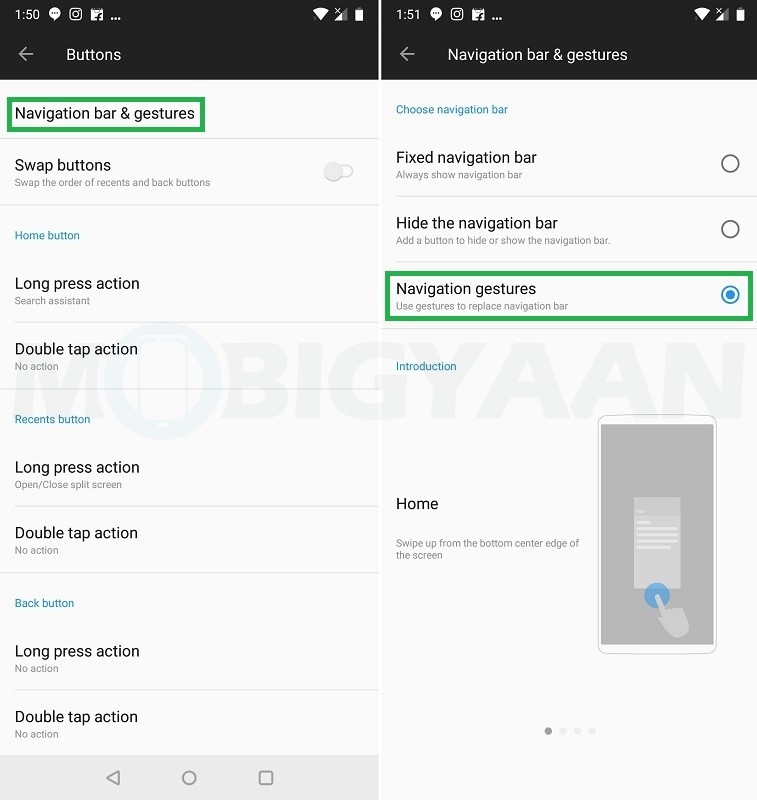
To enable on-screen navigation gestures, head over to the Settings > Buttons > Navigation bar & gestures menu and then select the ‘Navigation gestures’ option. Once you do that, you will see a demo below that option showing how to use the navigation gestures.
To go to home screen, you have to swipe up from the bottom center edge of the screen. To go back, you have to swipe from the left or right side of the bottom of the screen. And, to access recent apps, you have to swipe up from the bottom center edge of the screen and pause.
3) Hide Navigation Bar
The OnePlus 6 boasts a 6.28-inch Full-HD+ Super AMOLED display that has an aspect ratio of 19:9. Well, this means the users get a lot of screen real estate, which is good for video watching, playing games or reading. However, if you aren’t using navigation gestures to navigate around the UI of this smartphone, then it means you are using the buttons on the navigation bar to navigate.
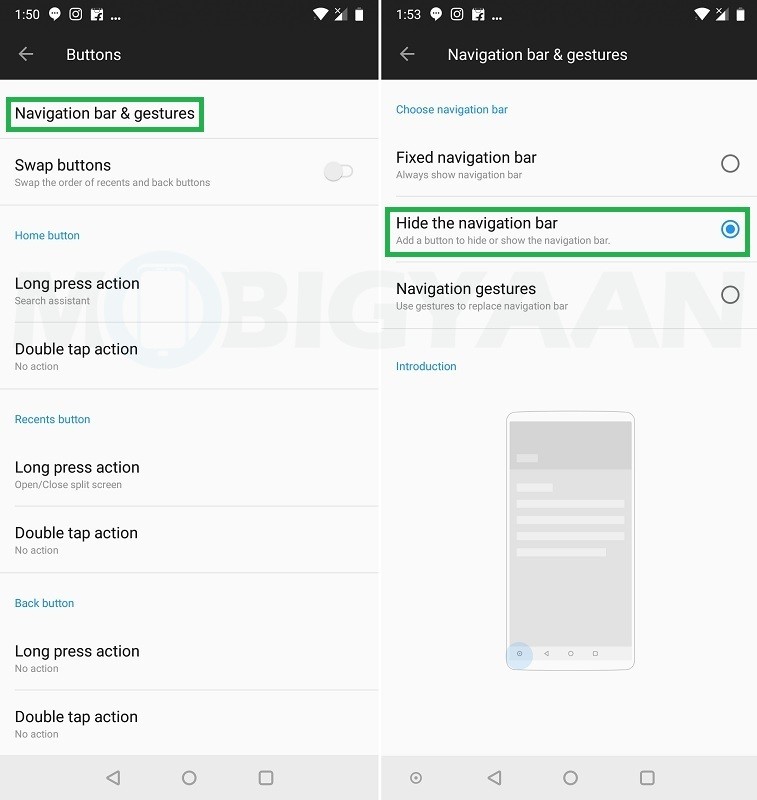
However, at times, there are chances that you mistakenly press any button on the navigation bar that takes you to a different screen. Well, to avoid this, you can hide the navigation bar. Head over to Settings > Buttons > Navigation bar & gestures menu and select the ‘Hide navigation bar’ option.
Once you do that, you will see a small circular button on the left side of the navigation buttons. Just tap on it to hide the navigation bar. As soon as you tap on that circular button, the navigation bar will disappear, and, to access it, you will have to swipe up from the bottom edge to go back, go home, or access recent apps.
However, to keep the navigation bar visible, you can tap on that circular bar again, or can simply select the ‘Fixed navigation bar’ option under the ‘Navigation bar & gestures’ menu.
4) Customize Gestures
The OnePlus 6, like its predecessor OnePlus 5 (and the mid-cycle refresh OnePlus 5T), comes with Gestures. With these gestures, you can perform different actions like taking a screenshot, opening the camera, or, opening any app that you want.
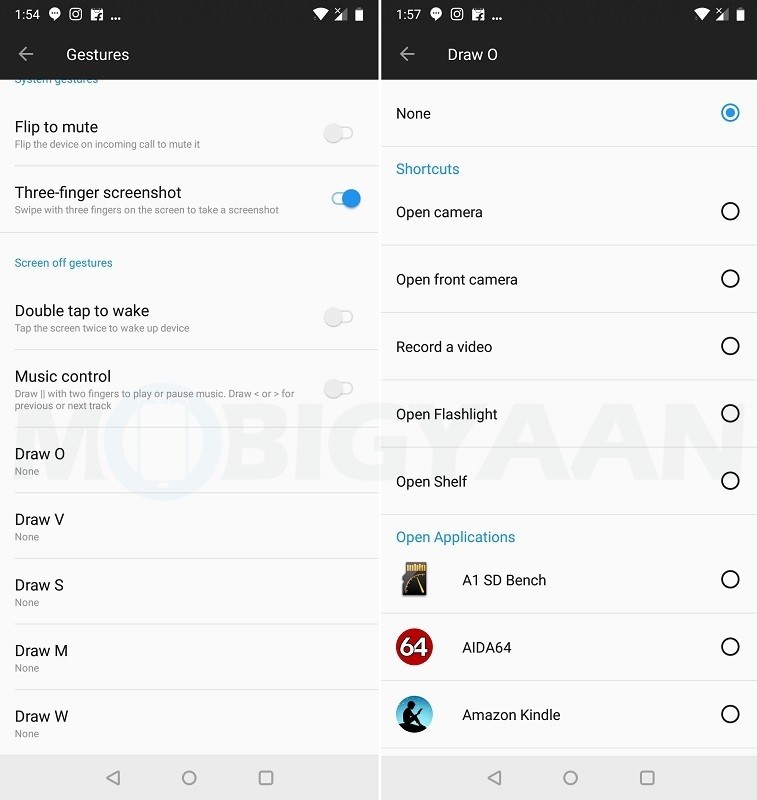
There are two types of gestures – System gestures and Screen off gestures. ‘System gestures’ let you take a screenshot by swiping three fingers on the screen, and, flipping the phone over to mute an incoming call.
Speaking of ‘Screen off gestures’, you can draw the letters O, V, S, M and W while the screen is off to either open the camera, record a video, turn on flashlight, or open the Shelf. Or, you can open any of the apps installed on your smartphone.
You can head over to the Settings > Gestures menu to enable these gestures.
5) Customize On-Screen Navigation Buttons
Unlike the OnePlus 5 that came with capacitive navigation buttons, the OnePlus 6, like the OnePlus 5T, only comes with on-screen navigation buttons. Reason? Well, reduced bottom bezel. However, just like OnePlus 5, you can customize the navigation buttons on OnePlus 6 to perform different actions and not be restricted only to going back, going home and opening recent apps screen.
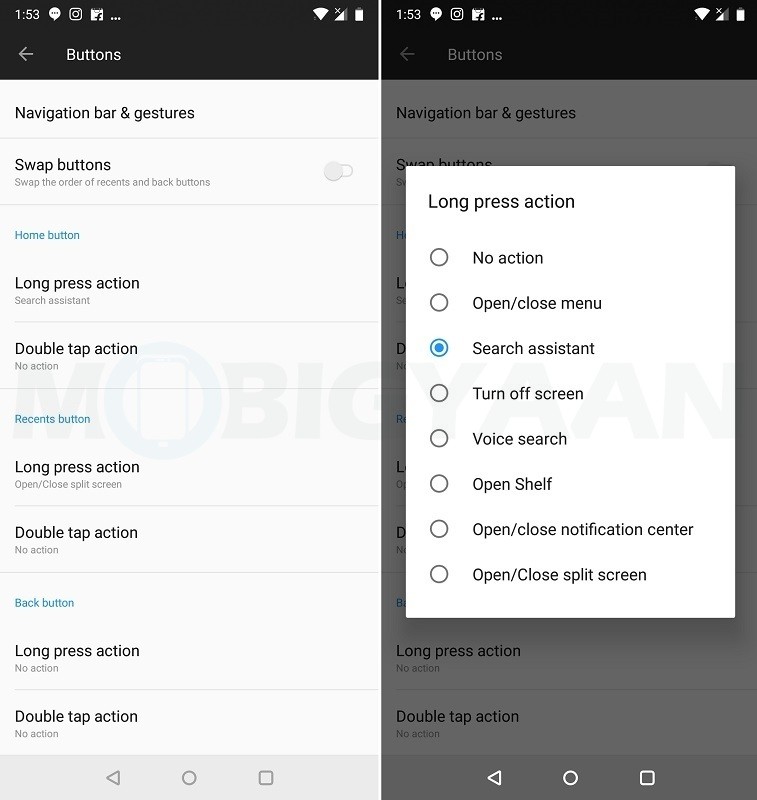
To customize the on-screen navigation buttons, head over to the Settings > Buttons menu, and from there, you will be able to customize the long-press and double-tap action of the back, home and recent buttons. You can check out the customization actions in the image above.
6) Double-tap to wake the device
One of our favorite features on OnePlus smartphones has been the ‘double-tap to wake’ gesture. You simply have to double-tap on the phone’s screen (when it’s turned off, of course) and the device wakes up. Well, this feature is present on the OnePlus 6 as well. However, it may not be enabled by default.
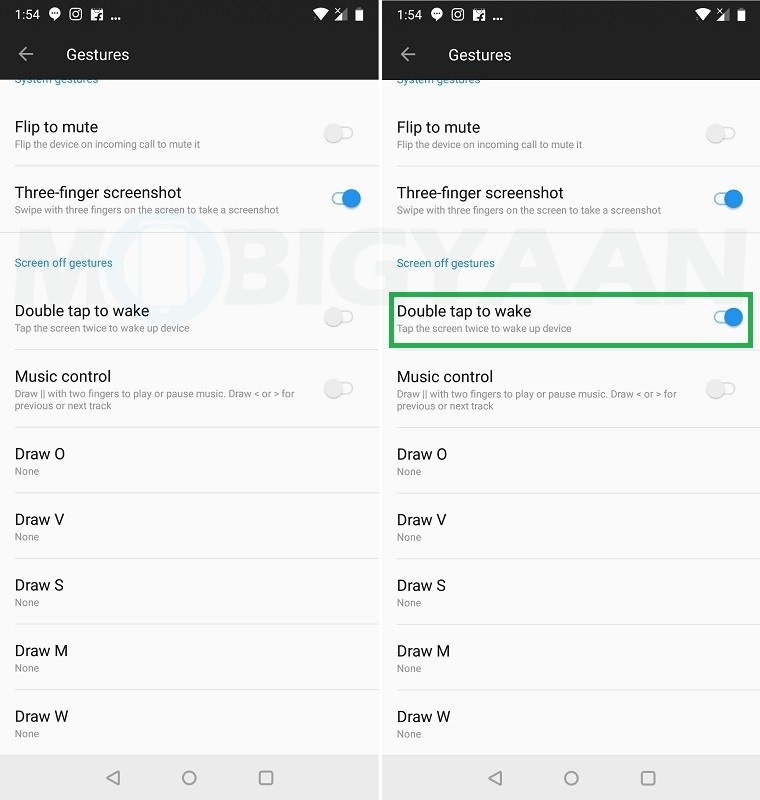
To turn on the ‘double-tap to wake’ gesture, just go to the Settings > Gestures menu and tap on the toggle button given right next to the ‘Double tap to wake’ option under the ‘Screen off gestures’ sub-menu.
7) Double-tap to lock the device
While the ‘double tap to wake’ gesture has been around on OnePlus smartphones for years now, what’s new this time is the ‘double tap to lock’ gesture. Unlike the ‘double tap to wake’ gesture that wakes up the device, the ‘double tap to lock’ gesture locks the device.
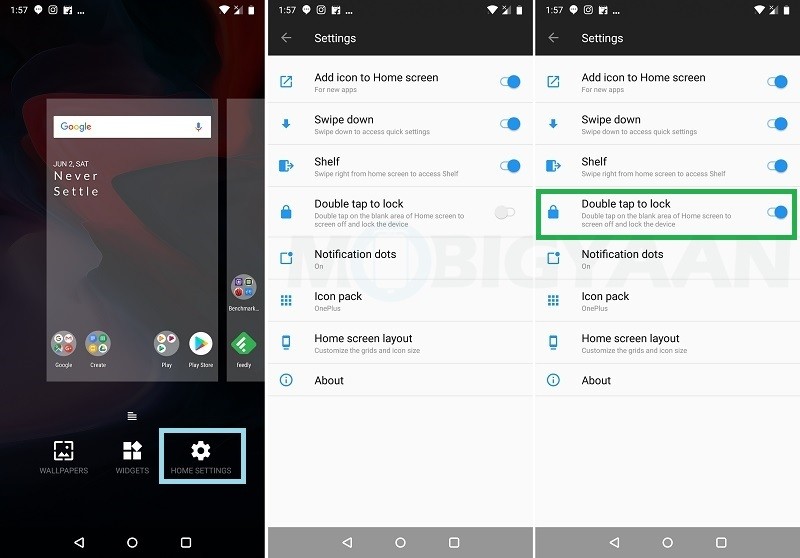
To enable ‘double tap to lock’, long-press on the home screen and then tap on the ‘Home Settings’ option. After that, tap on the toggle button given right next to the ‘Double tap to lock’ option. Having said that, do keep in mind that this gesture only works on the home screen, meaning you can only double tap on the home screen to lock the device.
8) Show Battery Percentage and Network Speed in Status Bar
Thanks to the notch on the OnePlus 6, unlike previous OnePlus smartphones, you couldn’t see the battery percentage in Status Bar without swiping down the quick settings menu. However, OnePlus added support for the battery percentage in Status Bar by rolling out OxygenOS 5.1.6 update. Hence, you can now easily see the battery level of your OnePlus 6 in percentage without having to swipe down the quick settings menu every time.
To display battery percentage in Status Bar, head over to the Settings > Status bar menu and tap on the ‘Battery style’ option. By default, the battery indicator style will be set to ‘Battery bar’. But, you can tap on ‘Battery percentage’ to display the battery percentage in Status Bar.
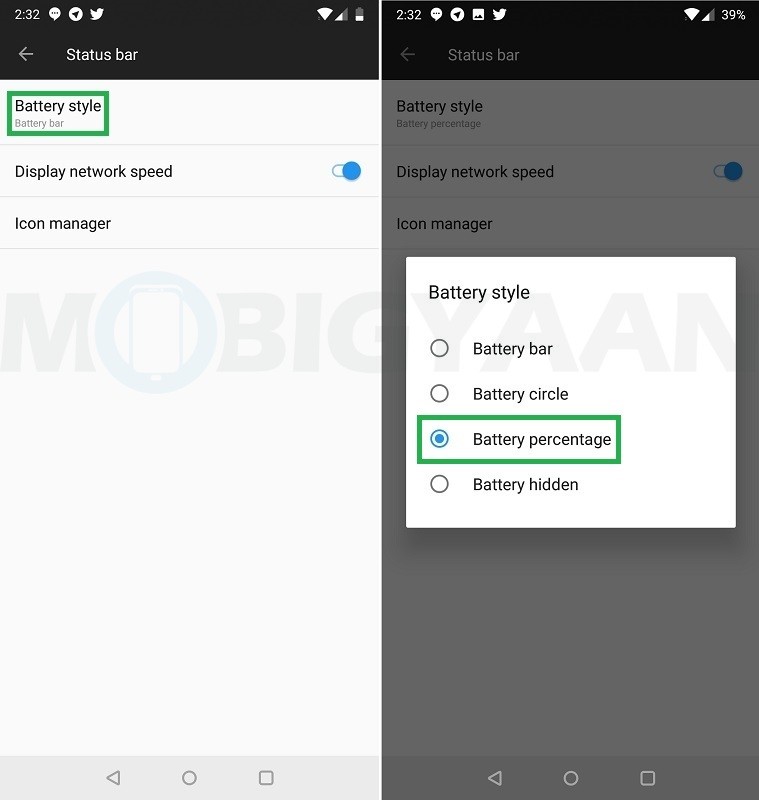
Having said that, you can also display the network speed in the Status bar. To do that, head over to the Settings > Status bar menu and tap on the toggle button given right next to the ‘Display network speed’ option.
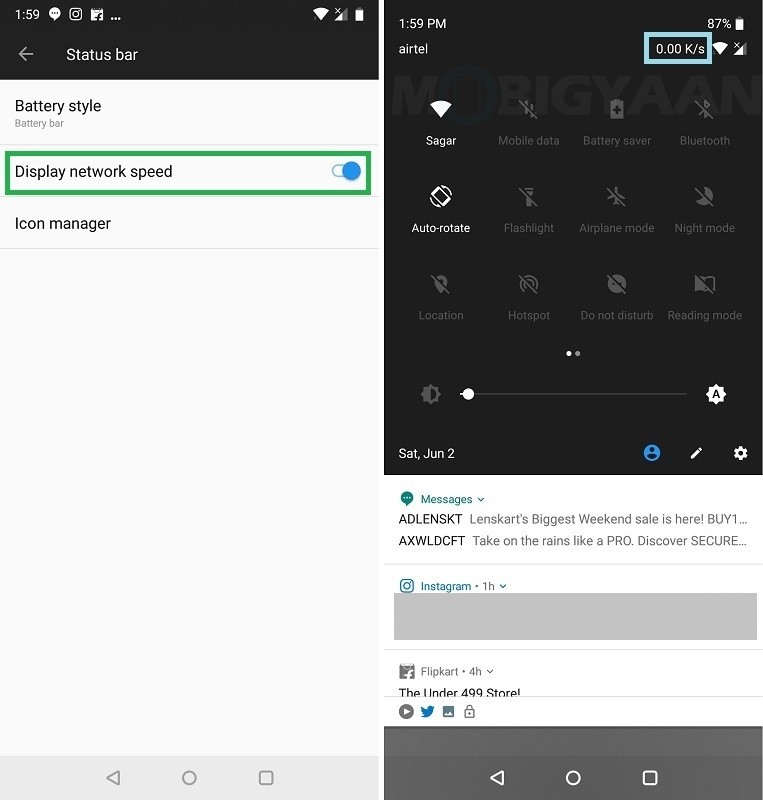
However, it’s worth noting that the network speed can also be only viewed by swiping down the quick settings menu, which in our opinion is very much inconvenient.
9) Customize Status Bar
As the OnePlus 6 comes with a notch, the screen space that the Status Bar used to get in previous OnePlus smartphones has now been reduced. You can now only see a handful of icons in the Status Bar. The left side of the notch shows notification icons whereas the right side of the notch shows system icons for Wi-Fi, Battery and so on.
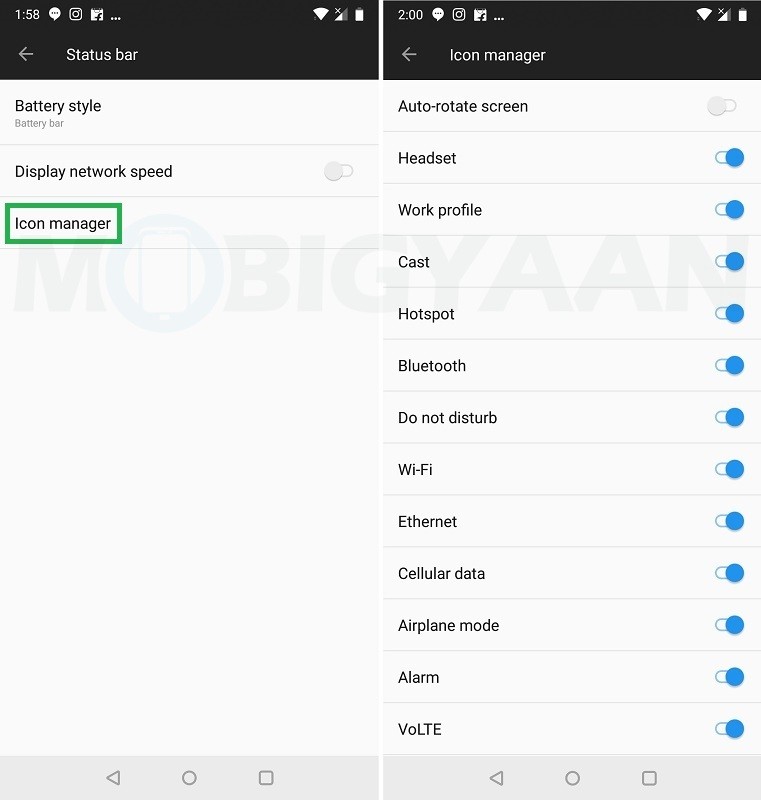
Due to the lack of screen, the Status Bar could get crowded real quick, hence, you can customize it by choosing which system icons show up in it and which ones don’t. You can do that by heading to the Settings > Status bar > Icon manager menu.
10) Enable Face Unlock
With OnePlus 5T, OnePlus introduced the Face Unlock feature that uses face recognition to unlock the smartphone. This feature got a lot of attention because it’s way faster (but not as secure) than Apple’s Face ID on the iPhone X. And owing to popular demand, OnePlus even rolled out the Face Unlock to older OnePlus smartphones like the OnePlus 3, 3T and 5. However, as one would expect, the Face Unlock made its way to the OnePlus 6 as well.
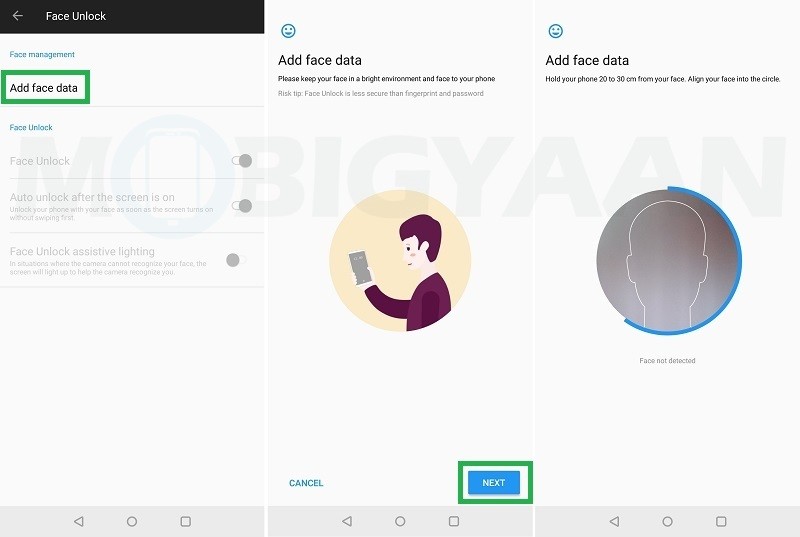
To enable Face Unlock, head over to the Settings > Security & lock screen > Face Unlock menu and follow the instructions.
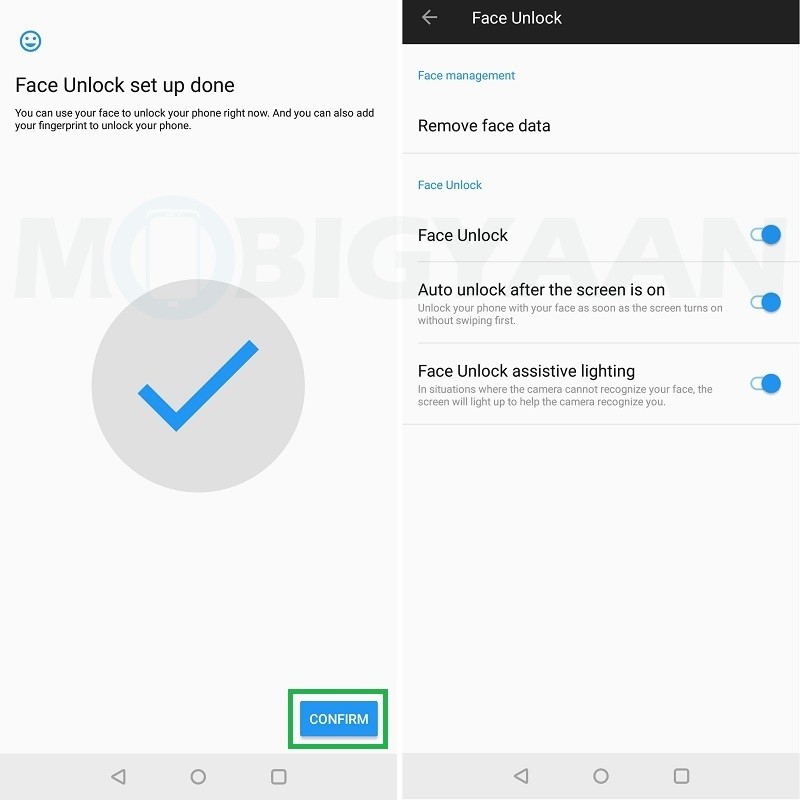
Having said that, do keep in mind that Face Unlock isn’t as secure as Apple’s Face ID. Hence, if you are too cautious about the security of your smartphone, you are better off using the fingerprint scanner.
11) Use Fingerprint Scanner to take photos
The OnePlus 6 comes with a fingerprint scanner at the back below the dual camera module. You can use this fingerprint scanner to unlock the smartphone. However, in addition to using it to unlock your OnePlus 6, it can also be used as a camera shutter button to take photos.
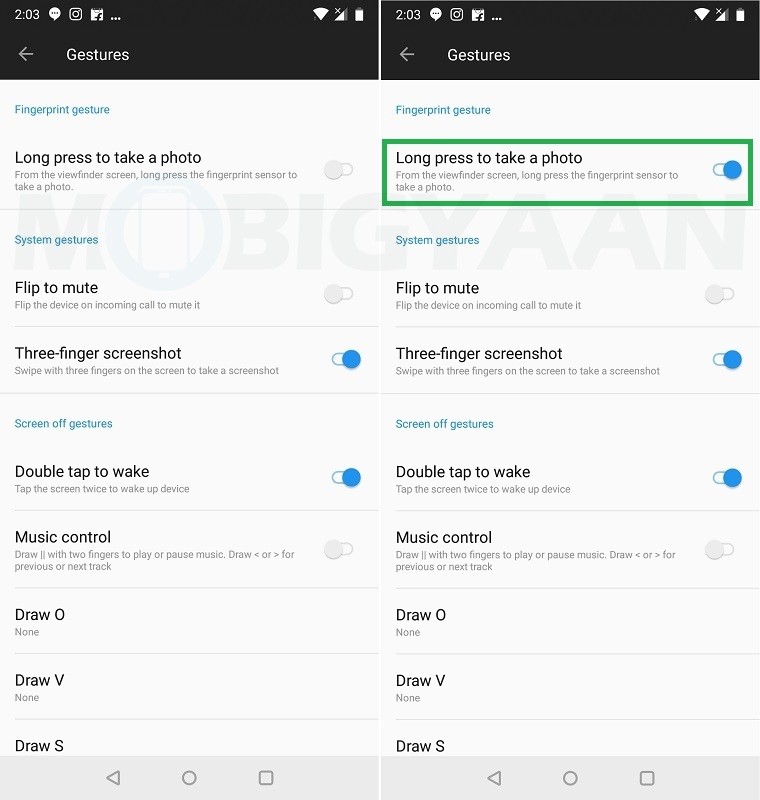
To use the fingerprint scanner on OnePlus 6 to take photos, head over to the Settings > Gestures menu and tap on the toggle button given right next to the ‘Long press to take a photo’ option. Once you do that, just long-press on the fingerprint scanner when you open the camera app. This should come in handy while taking selfies.
12) Record videos in Slow Motion
Previous OnePlus smartphones like OnePlus 5 and 5T did support slow motion video recording. But, with OnePlus 6, OnePlus has upped the ante a bit. With OnePlus 6, you can now record slow motion videos at up to 480 frames/second.
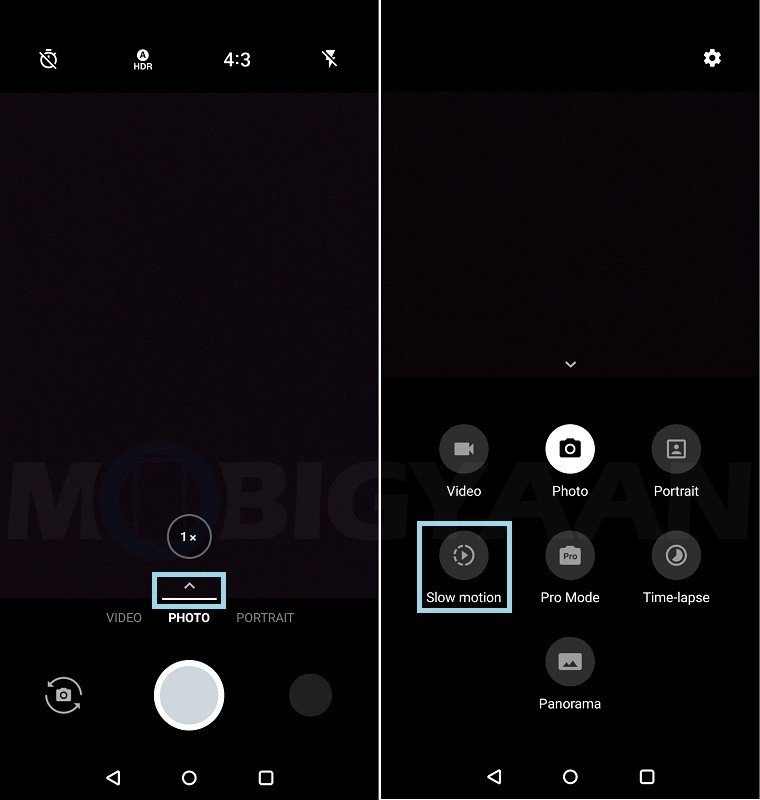
To record a slow motion video with OnePlus 6, open the Camera app, tap on the upward facing arrow, and then tap on ‘Slow motion’.
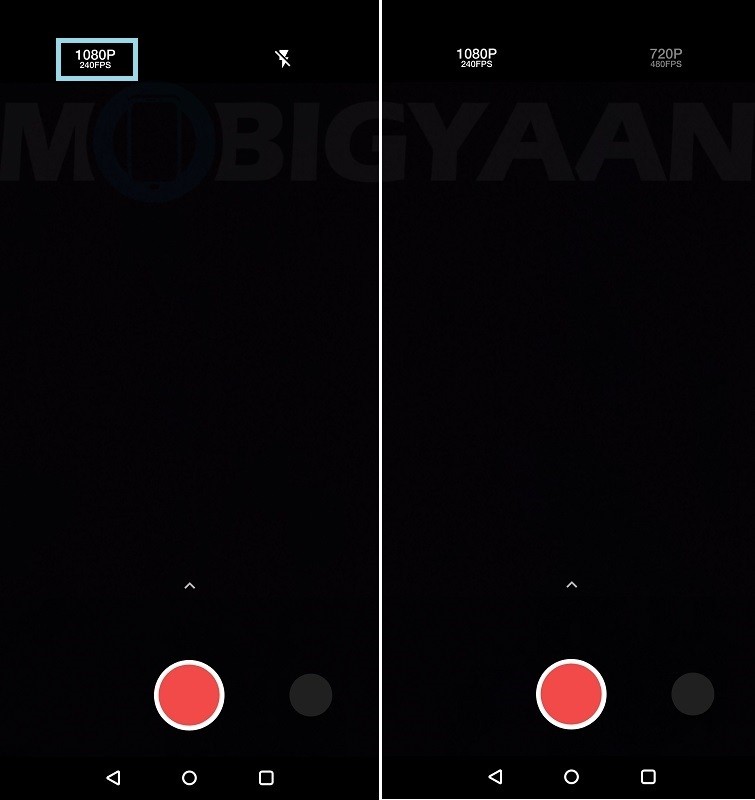
After that, you will see two options at the top of the screen. One on the right will let you enable/disable the flash, whereas the one on the left will let you select the frame rate. By default, the frame rate for recording slow motion video is 240 FPS in 1080p resolution. To change it to 480 FPS, just tap on the ‘1080P’ option and then select the ‘720P’ option that appears on the right side of the screen.
By now, it should be clear to you that you can record slow motion videos either in 240 FPS or 480 FPS. The videos recorded in 240 FPS will have 1080p resolution whereas the ones recorded in 480 FPS will have 720p resolution.
13) Record videos in 4K resolution
In addition to recording videos in slow motion, you can also record videos in 4K resolution with the OnePlus 6. By default, the video resolution will be set to 1080p. To change it to 4K, open the Camera app, tap on the ‘Video’ tab, and then tap on ‘1080P’ option at the top.
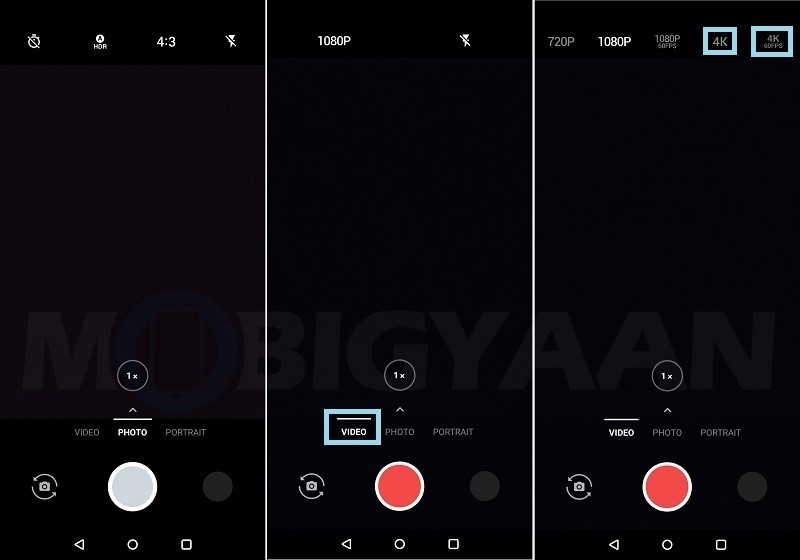
Doing that will show you a total of five options – 720P, 1080P, 1080P at 60 FPS, 4K, and, 4K at 60 FPS. You can tap on either ‘4K’ or ‘4K 60 FPS’ depending on your needs. But, do keep in mind that 4K videos have larger file sizes, hence, do make sure you have enough space on your smartphone before you start recording videos in 4K resolution.
14) Customize Bokeh Effect
Just like the OnePlus 5 and 5T, the OnePlus 6 also comes with dual rear cameras. However, unlike the OnePlus 5 that had secondary camera for taking photos of distant objects, and OnePlus 5T that had secondary camera for low-light photos, the secondary camera on the OnePlus 6 is dedicated for capturing depth information which is used to give Bokeh Effect to photos taken in Portrait Mode.
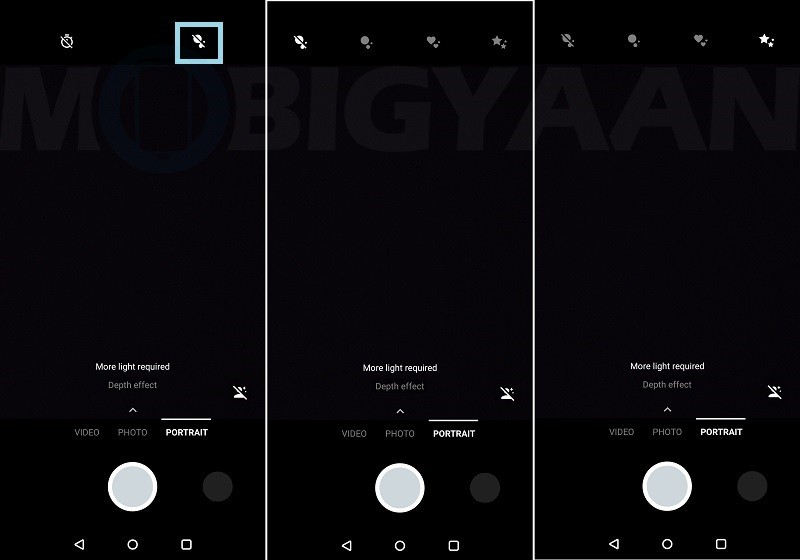
However, what’s interesting to see here is that with OnePlus 6, you can give different Bokeh Effects to your photos by adding hearts and stars. To do that, open the Camera app, tap on the ‘Portrait’ tab, and then tap on the two small circles right next to the timer icon. Doing so will show you three different Bokeh Effects. Tap on the one you prefer to use.
15) Capture images in RAW format
Like OnePlus 5 and 5T, the OnePlus 6 also allows its users to capture photos in RAW format. If you are a photographer, we don’t need to tell you the benefits of capturing photos in RAW format. But for those unaware, RAW format is preferred over JPEG by many because it isn’t compressed and it contains less information. Well, this helps the photographers edit the images to their liking with greater control.
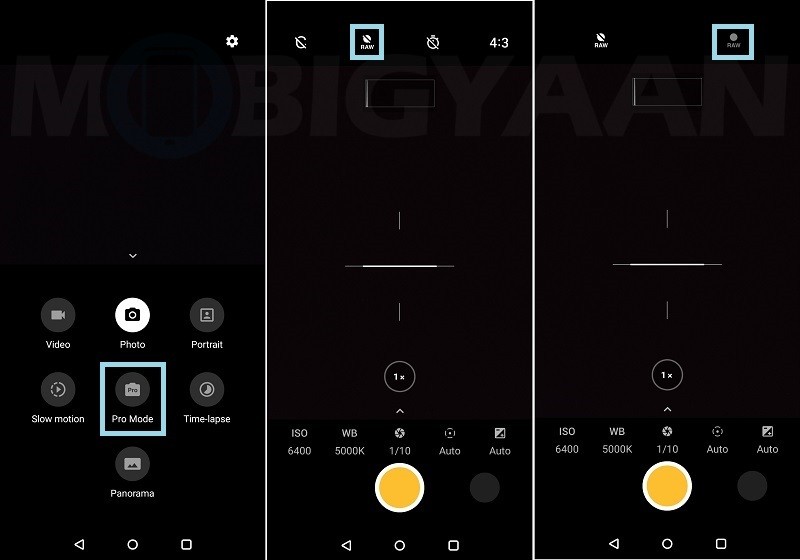
To capture photos in RAW format with OnePlus 6, open the Camera app, tap on the upward facing arrow, and select ‘Pro Mode’. After that, tap on the ‘RAW’ button that appears on the top next to the letter ‘C’. Once you do that, you will see another ‘RAW’ button appearing on the right side. Just tap on it and you are good to go.
16) Turn on Gaming Mode to avoid disturbance while gaming
Receiving notifications while gaming on your smartphone can be annoying, especially when you are leading your clan to victory. Well, that won’t be the case if you have the OnePlus 6. The OnePlus 6 comes with Gaming Mode that blocks notifications (except calls and alarms) when it’s turned on.
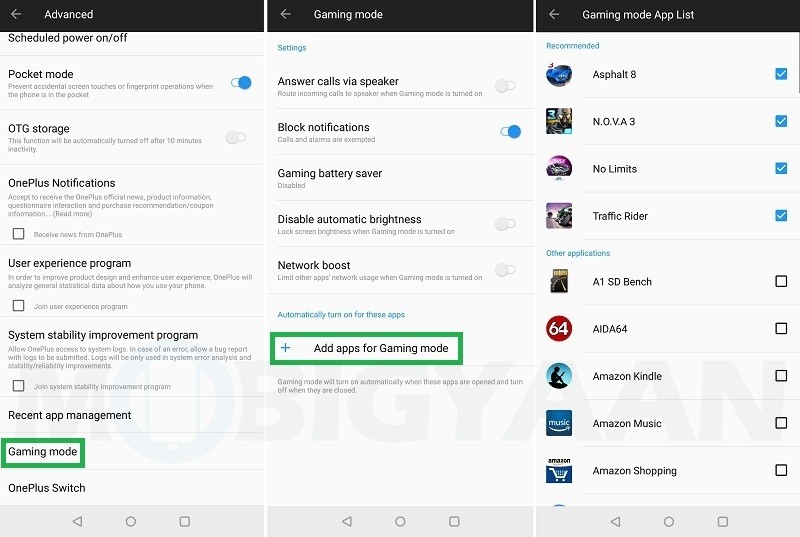
To set up Gaming Mode, head over to the Settings > Advanced > Gaming mode menu and customize it to your liking. You can turn on the Gaming Mode either from the Quick Settings, or set it up to be turned on automatically for certain games by tapping on the ‘Add apps for Gaming mode’ option and selecting the games.
The Gaming Mode also has an option called Network Boost, which when turned on, limits other apps’ network usage. This is useful when you are playing a game that requires active Internet connection.
17) Set up Reading Mode for a better reading experience
OnePlus introduced Reading Mode on OnePlus 5, and it’s present on the OnePlus 6 as well. With Reading Mode, the screen of your OnePlus 6 turns to grayscale to offer you a reading experience that’s similar to that on a Kindle. But that’s not it. The Reading Mode also uses the smartphone’s ambient light sensor to automatically adjust the screen color temperature based on the surrounding lighting conditions.
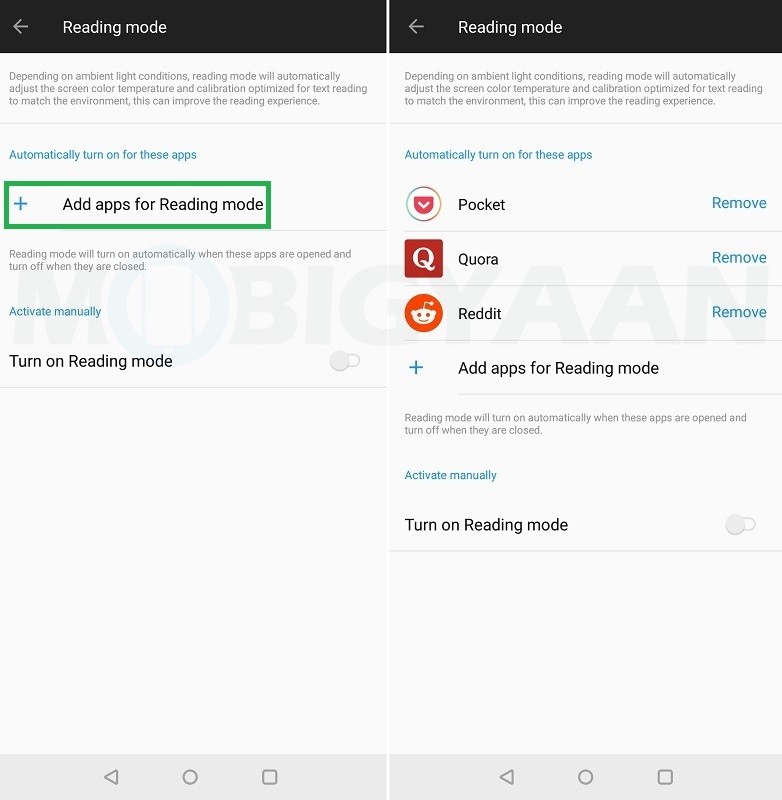
You can turn on the Reading Mode either from the Quick Settings menu or by heading over to the Settings > Display > Reading Mode menu and tapping on the toggle button given right next to the ‘Turn on Reading mode’ option.
That said, just like the Gaming Mode, you can set up the Reading Mode to turn on automatically when you open certain apps. To do that, tap on the ‘Add apps for Reading mode’ option and select the apps.
18) Turn on Night Mode automatically
Apart from Reading Mode, the OnePlus 6 also comes with Night Mode. It is useful for those who have a habit of using their smartphone at night or in low-light as it blocks the blue light being emitted from the smartphone’s screen that is harmful to the eyes.
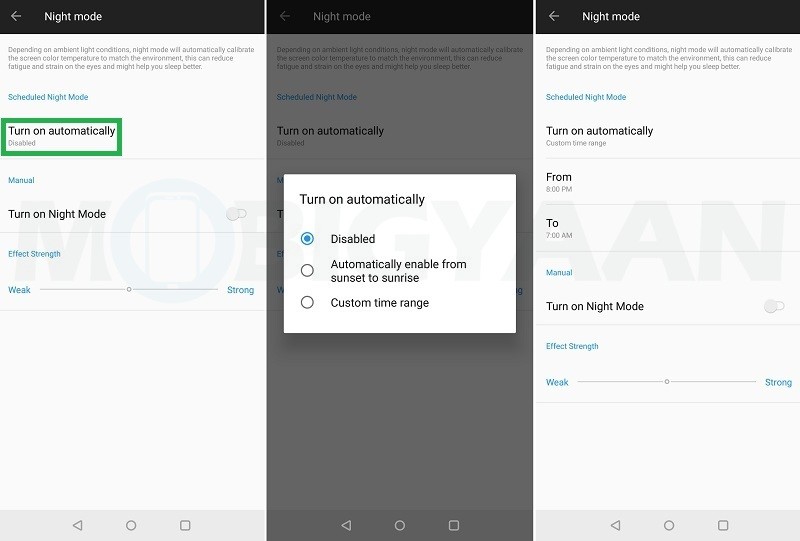
With Night Mode turned on, the emission of blue light is stopped by overlaying a yellow-ish filter on the screen. And, just like Gaming Mode and Reading Mode, the Night Mode can also be turned on from the Quick Settings, but, you can also set it up to turn on automatically by heading over to the Settings > Display > Night mode menu and tapping on the ‘Turn on automatically’ option. From there, you can choose whether you want the Night Mode to turn on automatically after sunset, or want it turned on between a specific time range.
19) Use two accounts of same app
There are times when we create two different accounts on same services/apps like Facebook, Instagram, Twitter and more for various reason. However, managing both the accounts could really be a chore if the official app of that service doesn’t allow using two accounts at the same time. Well, if you own the OnePlus 6, you don’t really have to worry much about it.
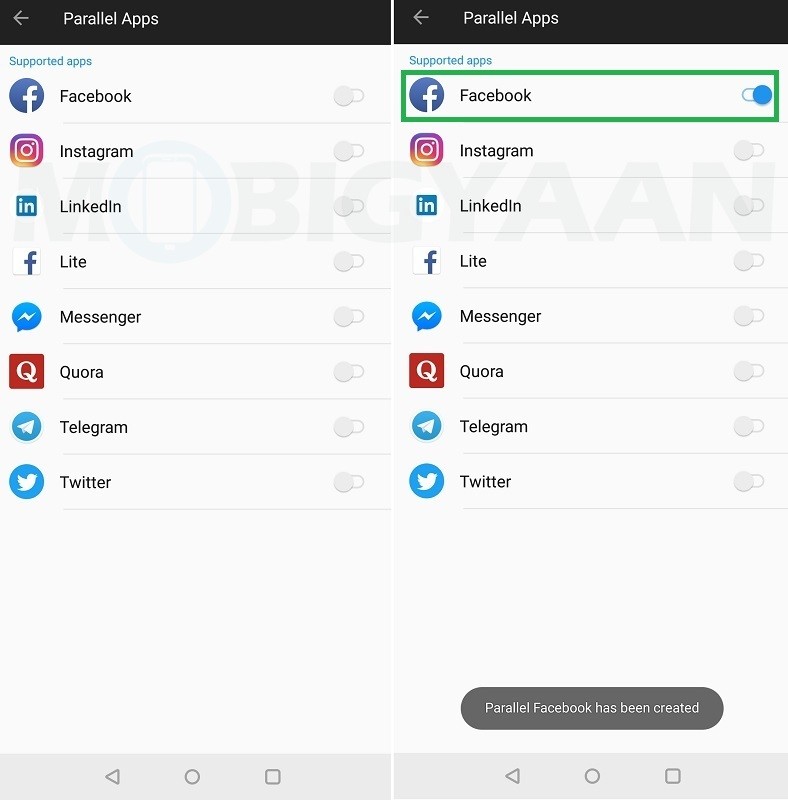
The OnePlus 6 comes with a feature called ‘Parallel Apps’ that lets you use two accounts of the same app. Using it is also pretty simple. Just head over to the Settings > Apps > Parallel Apps menu and tap on the toggle button next to the app that you want to use the second account of on your OnePlus 6.
For instance, if you want to use two accounts of Facebook, just tap on the toggle button right next to Facebook and you will see a message on the screen saying “Parallel Facebook has been created”. Well, this will create a clone of Facebook which will let you sign in using a different account. You can click here for more information.
20) Lock Apps
We have seen many people who use app lockers to lock apps even after securing their smartphone with a PIN/Pattern/Password or fingerprint unlock. Well, more security is always better. But, to achieve that, we have to download third-party apps. But that won’t be the case if you own OnePlus 6 as it comes with in-built app locker.
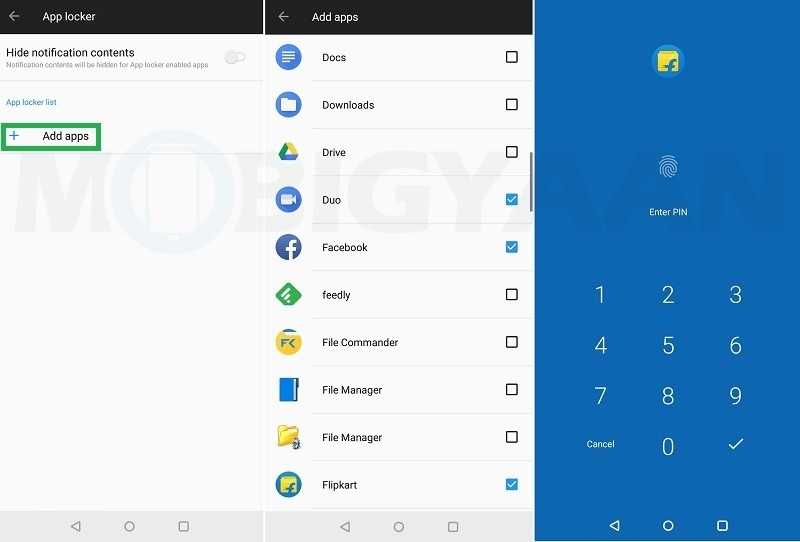
To lock apps on OnePlus 6, head over to the Settings > Security & lock screen > App locker menu and then select the apps you want to lock by tapping on the ‘Add apps’ option. Once you do that, you will be required to enter the phone’s security PIN or use the registered fingerprint to open the locked app.
21) Hide Files
In addition to locking apps on the OnePlus 6, you can also hide files. This can be done easily using the ‘Lockbox’ feature in OnePlus’ File Manager app. Once you move a file to Lockbox, it will remain hidden and can only be accessed after the security PIN is entered.
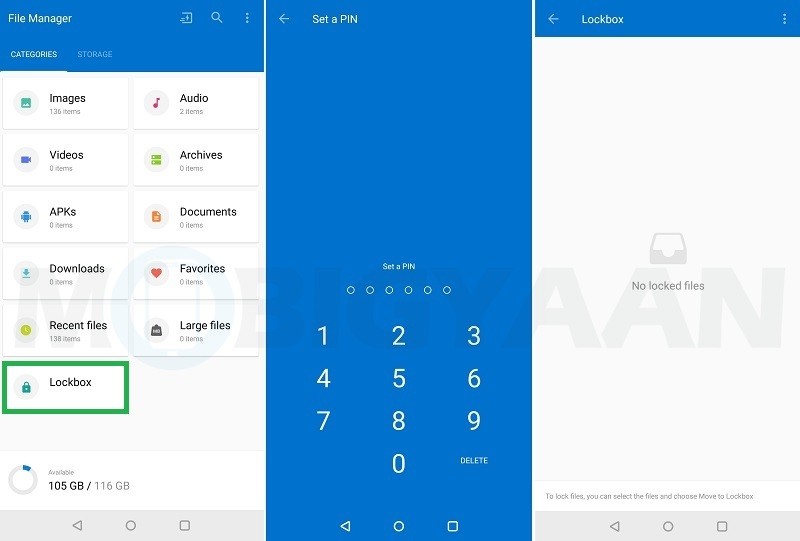
To hide a file by sending it to Lockbox, first find it inside the OnePlus’ File Manager, then long-press on it and tap on the ‘Move to Lockbox’ option from the three-dot menu button that will show up at the top-right corner of the screen. Once you do that, the file will disappear and will only be accessible from within Lockbox which can only be accessed using a 6-digit PIN.
22) Disable Shelf
OnePlus smartphones come with what’s called ‘Shelf’ which is accessed by swiping right on the home screen. Shelf is where you get quick access to different information, contacts, apps and more. You can also customize Shelf by adding different widgets to it. However, I personally don’t use it and it turns out to be annoying when I somehow end up on the Shelf screen. Well, I’m pretty sure I’m not the only one who doesn’t use Shelf. And, if you too don’t use it, there’s a way you can disable it.
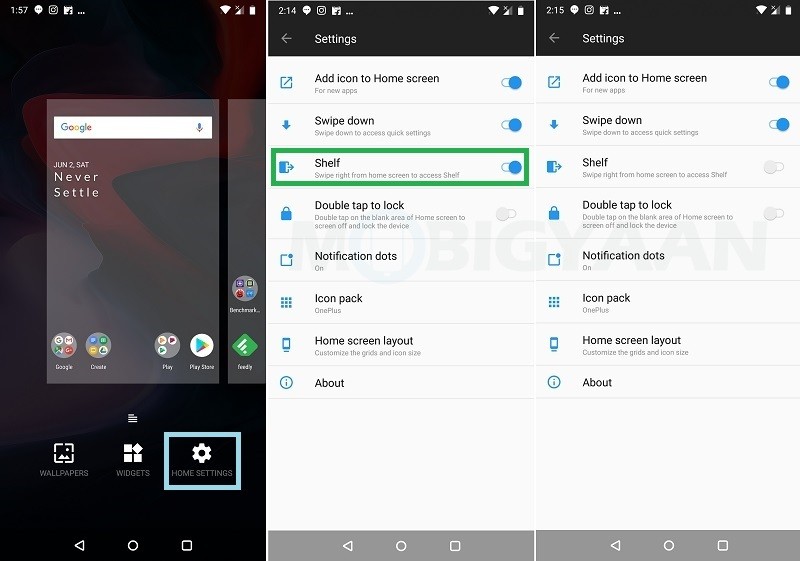
To disable shelf, long-press on the home screen and then tap on ‘Home Settings’. After that, tap on the toggle button right next to the Shelf option to disable it. The toggle button will turn from blue to red color once Shelf is disabled.
23) Enable/Disable Notification Dots
Google brought Notification Dots to Android last year with the release of Android 8.0 Oreo. And, as the OnePlus 6 runs Android 8.1 Oreo out-of-the-box, it also comes with this Notification Dots feature. With Notification Dots, you can quickly take a look at a certain app’s notification by long-pressing on its icon. However, if you happen to dislike this feature, it can be turned off pretty easily.
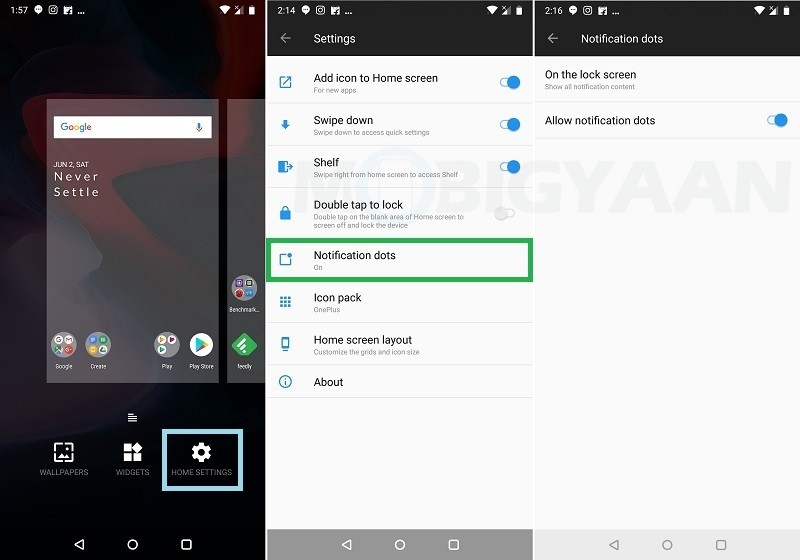
Notification Dots on OnePlus 6 are turned on by default, so to disable them, long-press on the home screen, tap on ‘Home Settings’, and then tap on the ‘Notification dots’ option. After that, tap on the toggle button next to the ‘Allow notification dots’ option to disable Notification Dots.
24) Change home screen layout
One of the best things about Android is that you actually get to customize the home screen of your smartphone the way you like using different launchers and apps. Well, you can do the same on OnePlus 6 as well using third-party apps. But, there’s one thing you can do that doesn’t require downloading any extra apps – changing the home screen layout.
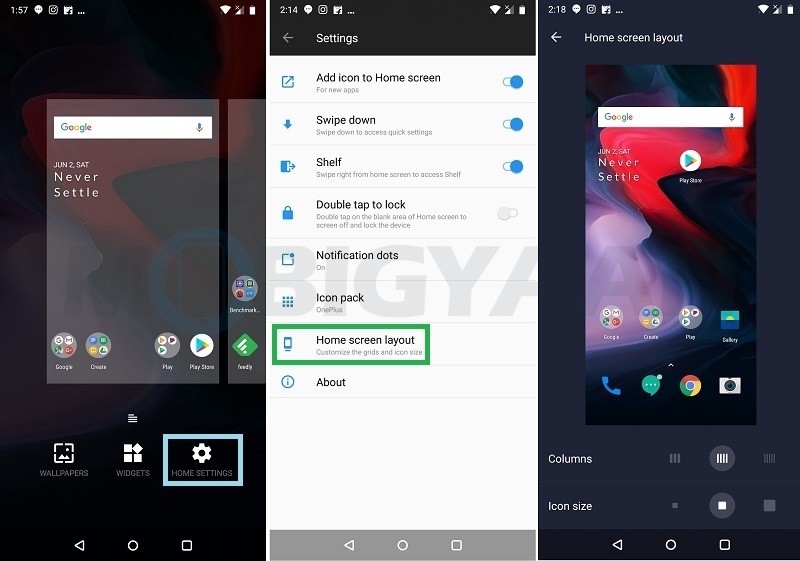
You can change the home screen layout of the OnePlus 6 by long-pressing on the home screen, tapping on ‘Home Settings’ option and tapping on ‘Home screen layout’. From there, you can change the icon size and the number of columns on the home screen. By default, the icon size is set to medium (center option) and the number of columns are set to five. If you want more icons on your home screen, you can set the icon size to small and column numbers to five.
25) Change Icons
The ability to change app icons on Android devices is nothing new. If you want to change the way the app icons look on your device, all you have to do is download an icon pack and apply it. But, the OnePlus 6 does come pre-loaded with some icon packs. By default, the icon pack named ‘OnePlus’ is applied, but, you can use icons from icon packs named ‘Round’ and ‘Square’ as well.
![]()
To change icons, long-press on the home screen, tap on ‘Home Settings’, tap on ‘Icon pack’ and then tap on the icon pack you want to use. If you want more options, you can always download an icon pack from the Play Store and it will show up in this section.
26) Turn On and Customize Ambient Display
The OnePlus 6 comes with AMOLED display, and, one of the best ways to utilize an AMOLED display is throwing in a feature called Always-On Display. Now OnePlus removed the Always-On Display feature from the OnePlus 6 with OxygenOS 5.1.5 update. However, the OnePlus 6 does have the Ambient Display feature.
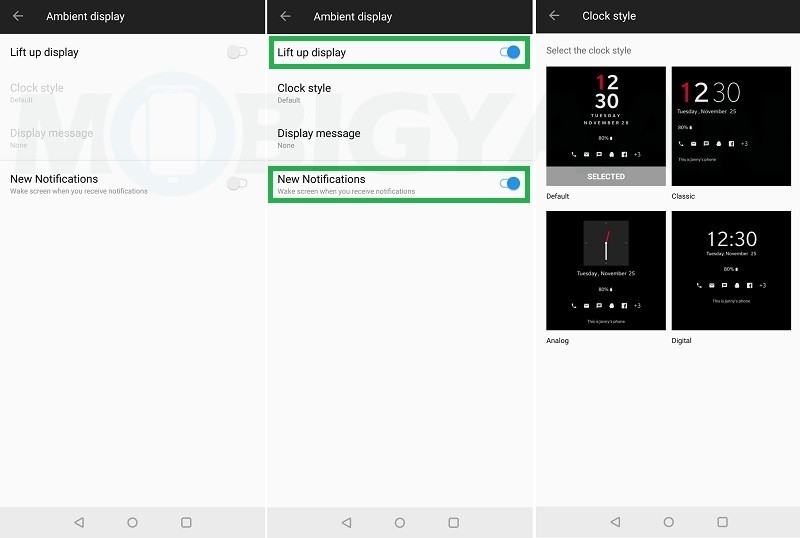
The Ambient Display feature shows information like time, day, date, battery level and notifications. To turn it on, head over to the Settings > Display > Ambient display menu and tap on the toggle button given right next to the ‘Lift up display’ option. This will show information on screen when you lift up the phone.
You can also tap on the toggle button given right next to the ‘New Notifications’ option if you want the screen to wake up when you receive a new notification. Furthermore, you can also write a display message to show on screen, and, can also customize the look of the Ambient Display by changing the clock style.
27) Enable USB OTG
The OnePlus 6 comes in three storage options – 64 GB, 128 GB and 256 GB (Avengers Edition). Well, this much of storage should be more than enough for most of the users. But, if you are that rare breed who can run out of space even on 128 GB and 256 GB storage variants, and want to free up some space quickly, then the ability to transfer data using USB OTG comes in handy.
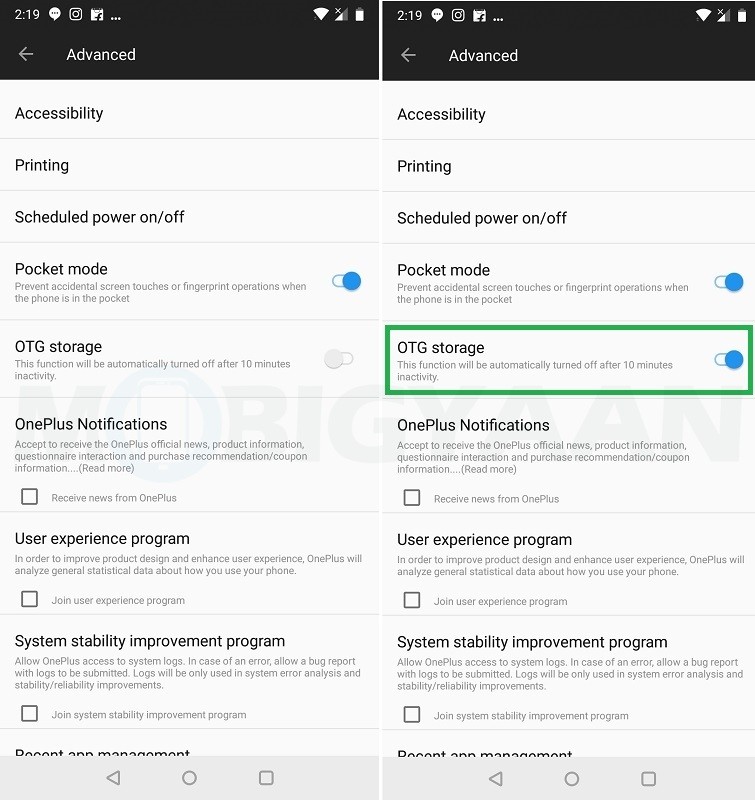
The OnePlus 6 has support for USB OTG, but, it’s turned off by default. To turn it on, head over to the Settings > Advanced menu and then tap on the ‘OTG storage‘ toggle.
28) Schedule power on/off
People often turn off the mobile data and Wi-Fi on their smartphones at night to avoid any disturbance to get a good night’s sleep. However, there are some people who also turn off their smartphones at night for complete peace of mind. Well, if you are one of them and own a OnePlus 6, you can automate the drill.
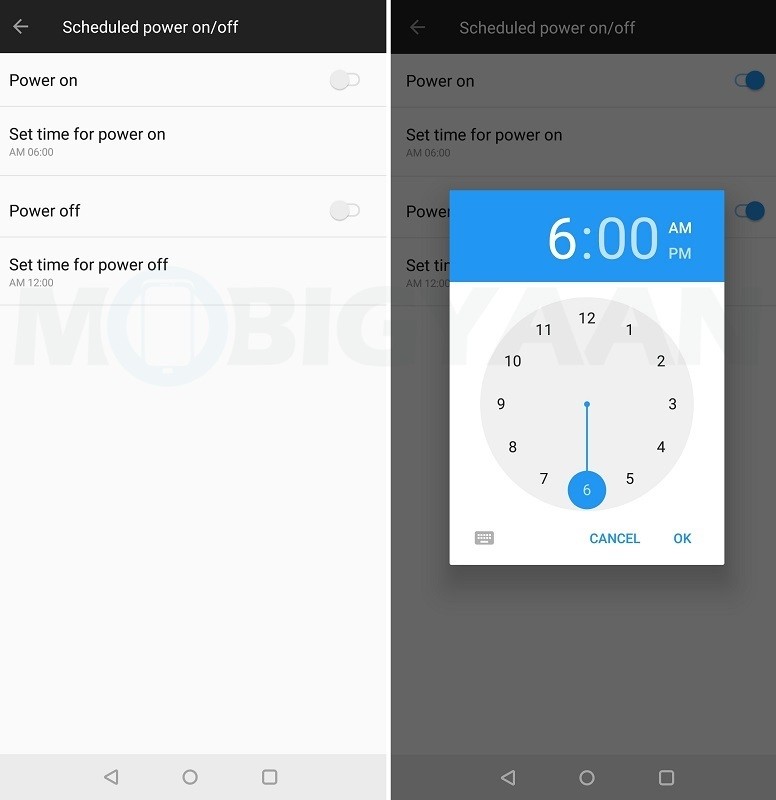
You can set the OnePlus 6 to power on and off automatically using the ‘Scheduled power on/off’ feature. To do so, head over to the Settings > Advanced > Scheduled power on/off menu and select the time at which you want the OnePlus 6 to turn on/off automatically.
29) Customize DND Preferences and turn it on/off automatically
Previous OnePlus smartphones like the OnePlus 3, 3T, 5 and 5T all came with an Alert Slider, but, the three modes that Alert Slider had were Silent, Do not disturb (DND) and Ring. Well, with OnePlus 6, OnePlus has replaced the DND mode for the Alert Slider with Vibration mode. Does it mean the DND mode is gone? No. It’s still present and can be customized. In fact, as opposed to previous OnePlus smartphones, it can be now turned on/off automatically.
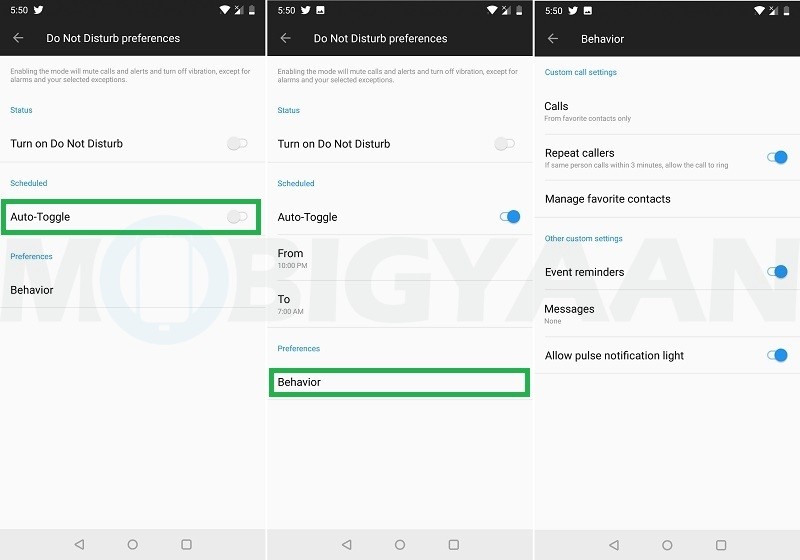
You can turn on the DND mode from the Quick Settings menu or by heading over to the Settings > Sound & vibration > Do Not Disturb preferences menu and tapping on the toggle button given right next to the ‘Turn on Do Not Disturb’ option.
To turn on the DND mode automatically, tap on the toggle button next to the ‘Auto-Toggle’ option and then select the start and end time. That said, to customize DND preferences, tap on the ‘Behavior’ option. From there, you can select exceptions for call and message notifications. You can choose to receive call and message notifications from anyone, from contacts only, from favorite contacts only, or from no one. You can add people to favorite contacts by tapping on the ‘Manage favorite contacts’ option and adding them to the list.
Furthermore, you can also disable notification light and event reminders when the DND mode is turned on.
30) Record Calls Automatically
While different countries have different laws and regulations regarding call recording, there are times when you have to record a call with or without the consent of the other person for some reasons. There are many apps available on the Play Store that let you record calls. But, if you own the OnePlus 6, you don’t have to do that as the OnePlus 6 comes with a call recording feature.
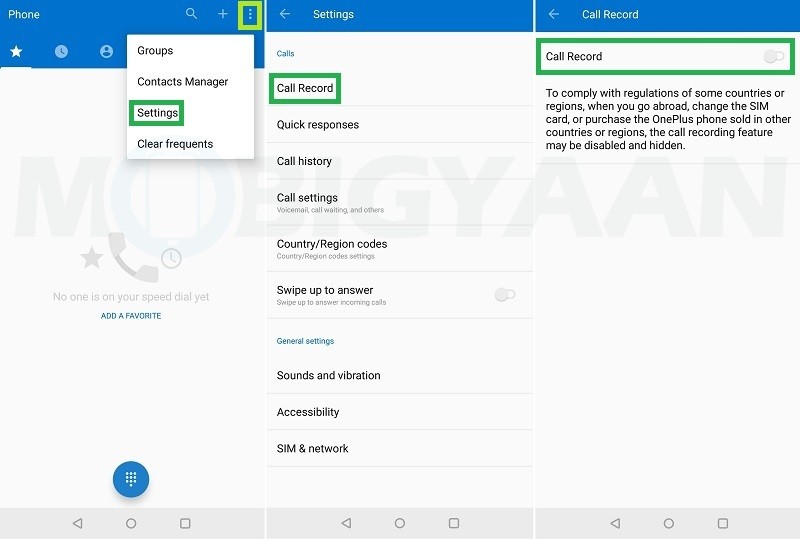
You can record a call by tapping on the cassette icon during a call, but, you also have the option to automatically record calls. To do so, open the Phone app, tap on the three-dot menu button in the top-right corner, tap on Settings, and then tap on the ‘Call Record’ option.
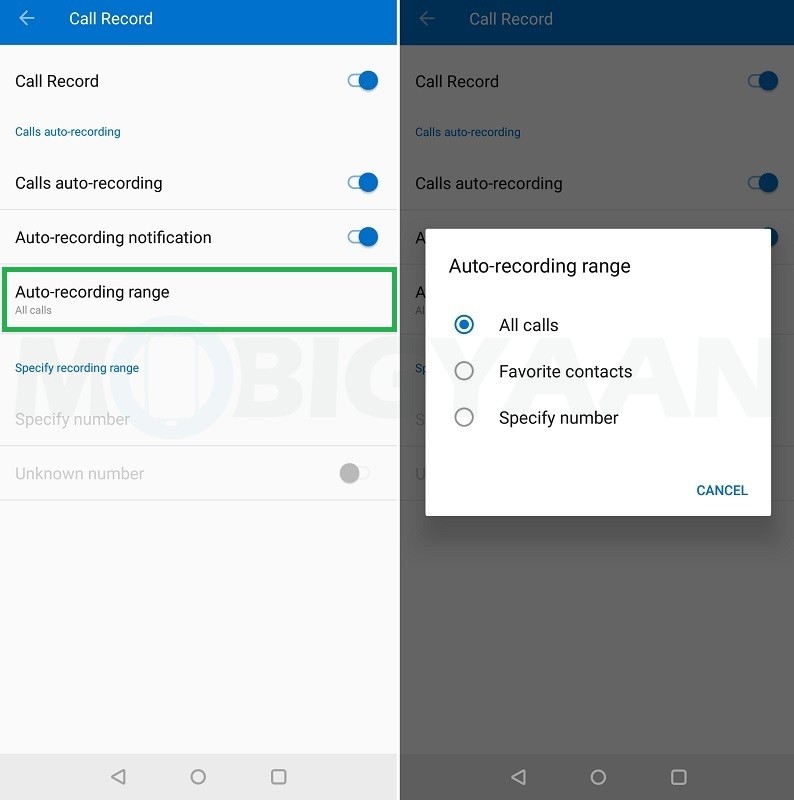
After that, tap on the toggle button given right next to the ‘Call Record’ option to enable call recording. Once you do that, tap on the toggle button given right next to the ‘Calls auto-recording’ option to record calls automatically.
You can tap on the ‘Auto-recording range’ option to choose whether you want to automatically record all calls, calls from favorite contacts, or calls from specific number(s). You can also record calls automatically from unknown numbers.
Well that’s it. Those were some of the OnePlus 6 tips, tricks and hidden features that should help you make the most out of your smartphone. If you think we missed out on something, feel free to let us know in the comments down below.
We will be publishing our OnePlus 6 review soon, so if you want to know something specific about the OnePlus 6, you can drop your questions in the comments down below.
Also Read: 32 Top OnePlus 6T tips, tricks and hidden features
